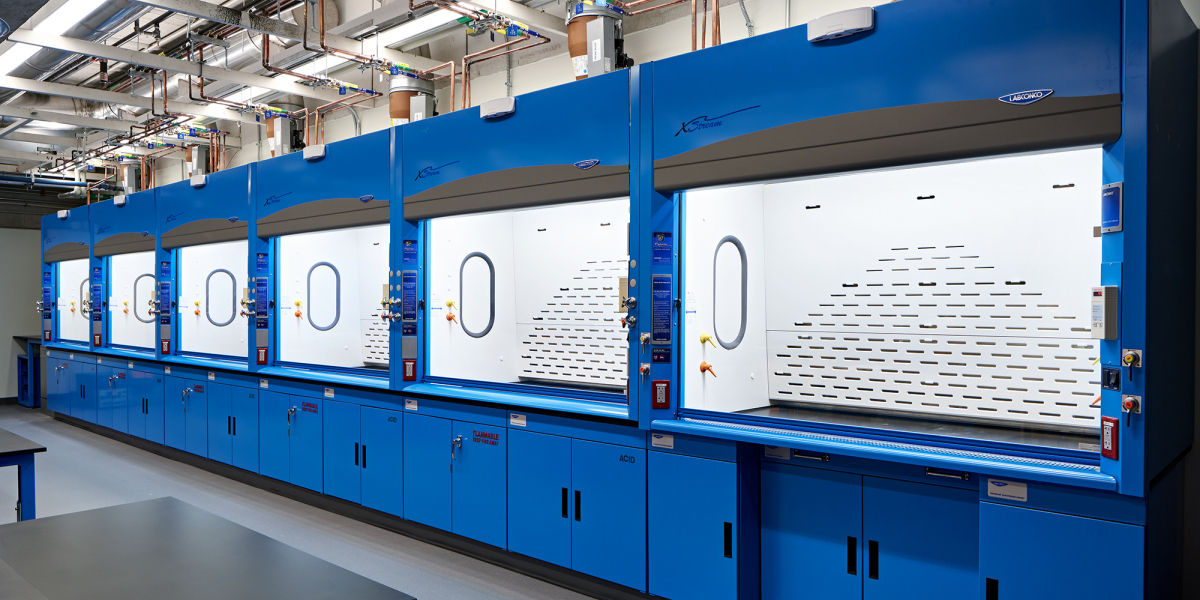Practically perfect fume hood containment

There has been a lot of discussion on Variable Air Volume (VAV) mechanical systems these days and many of us may have forgotten how a Constant Air Volume (CAV) fume hood is supposed to work. Here at Labconco, we have found times where our customers are confused that the face velocity increases as the sash is closed, or confused on how multiple CAV or bypass hoods can share a single blower, while not influencing each other.
Let’s clear this up.
What is a bypass fume hood?
The industry definition of a bypass hood comes to us from Laboratory Ventilation, ANSI/AIHA/ASSP Z9.5 3.2.2 (ANSI Z9.5), where we find, “Bypass hoods have a route for air entering the hood (the bypass mechanism) which opens as the sash closes…” and, “the face velocity at the hood opening should not exceed three times the nominal face velocity with the sash fully open…” Based on this definition, It is indeed normal for the face velocity, usually measured in feet per minute (fpm), to increase as the sash is closed as long as the face velocity does not exceed three times the full open face velocity.
ANSI Z9.5 goes on to note that, “…excessive velocities, greater than 300 fpm, can disrupt equipment, materials, or operations inside the hood possibly creating a hazardous condition.” In addition to defining limits on how much the face velocity can change, the standard is also clear on limiting the change in volumetric rate, usually measure in cubic feet per minute (CFM), noting, “The hood exhaust volume should remain essentially unchanged (less than five percent change) while the sash moves through its range of opening and closing. This is important to the design of the exhaust system.”
The Labconco design criteria for bypass fume hoods is that they do not exceed three times the full open face velocity at any sash position. We test each hood configuration we make by taking an ASHRAE 110 face velocity profile at multiple sash positions to validate design conformity in relation to ANSI Z9.5.
CAV mechanical system compatibility
In an effort to ensure Labconco bypass hoods have mechanical system compatibility, we require each model to show no detectable difference in static pressure loss, usually measured in inches of water, across all sash positions. This is but one benefit of developing hoods in our Airflow test lab.
Consequently, these hoods will hold virtually the same volumetric rate of air (CFM) regardless of whether the sash is fully open or closed. This proves that no single Labconco hood can influence the airflow through another hood on a shared constant volume mechanical system, which is a requirement of ANSI Z9.5.
We also need to prove the robust containment on these hoods, and not just when the sash is static. The ASHRAE 110 protocol requires that a Sash Movement Effect (SME) test is conducted on hoods. This means for 300 seconds, four liters per minute of Sulfur Hexafluoride is released inside the fume hood, about 10,000 ppm in the plume, while a tracer gas detector, which is located in the breathing zone of a mannequin, records data. For the first 30 seconds, the sash is closed and supply air to the hood is only available through the bypasses. After 30 seconds the sash is opened. 60 seconds later the sash is closed, and the process is repeated. Keep in mind, the face velocity is varying by up to three times during this sequence. Through SME testing, all Labconco Protector Fume Hoods show 0.00 ppm average and 0.00 pmm maximum spike for the full 300 seconds of the test.
In summary, all of Labconco’s Protector Series fume hoods are fully compliant with the industry definition of a bypass fume hood, compatible with a CAV mechanical system and show no detectable loss of containment across the full range of practical face velocities.
| chevron_left | VIDEO: Lyo-Works OS for Labconco FreeZone Freeze Dryers | Articles | Glassware Washer and Detergent – Synergy at its Finest | chevron_right |






